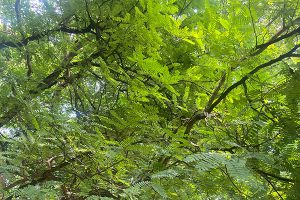14 Sep Tamarindus indica
Tamarindus indica also known as Tamarind tree is an evergreen leguminous tree with edible fruit shaped like a sausage. Its root, bark, and leaves possess varied medicinal, nutritional, and culinary properties. It has attractive pale yellow and pink flowers, which are also edible.
Tamarindus indica grows in India, Sudan, Pakistan, Bangladesh, Nigeria, and in most tropical countries.
- Tamarind is used as flavor in many culinary dishes. It is favored for its wide range of taste. Ranging from sweet and tangy, to sour and tarty, depending on how ripe the fruit is. Its immature pods are added to stews, soups, and sauces; and sometimes eaten fresh.
- Apart from serving as seasoning to foods, tamarind is also added to flavor juices, jellies, syrups, and pastes.
- Its leaves go well in salad and vegetable servings.
- Its leaves are boiled in tea to treat measles in children.
- Its mature seeds ground into powder can be used to cure dysentery and diarrhea.
- Its bark work well to relive sores, ulcers, boils, and rashes.
- The bark of tamarind contain tannins that can be used to tint or dye clothes.
- Its seed oil is useful for making paints, varnishes, and for burning in lamps.
- Its wood is useful for general carpentry, mortal, boat, wooden utensils, panels and other furniture.
- A decoction of its flower buds can be used to treat bedwetting and urinary complaints in children.
- Tamarind provide natural antimicrobial benefits.
- Tamarind have laxative and aphrodisiac properties.
Tamarindus indica serve a variety of medicinal uses including: antidiabetic, antimicrobial, antivenomic, antioxidant, antimalarial, antiasthmatic, hepatoprotective, and anti-hyperlipidemic.


